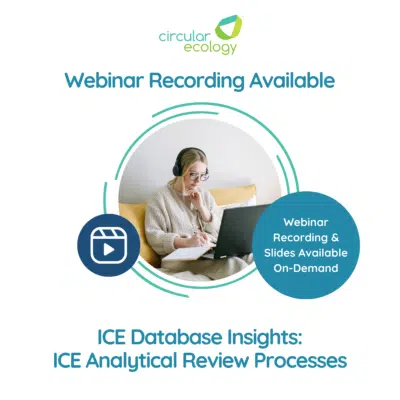Environmental Impacts
There are many more environmental impacts beyond just global warming (also called carbon emissions, GHG emissions, climate change). Below is a list of wider environmental impact categories. The impact categories have been taken from a Life Cycle Assessment (LCA) method known as ReCiPe.
Wider environmental impacts include (but not limited to):
Climate change: A measure of the release of greenhouse gas (GHG) emissions into the atmosphere.
When released into the atmosphere these gases absorb and emit thermal infrared radiation, trapping heat within the atmosphere, and contributing to climate change. This is also known as the carbon footprint, or global warming potential (GWP).
Ozone depletion: Depletion of the ozone layer. Ozone is a harmful pollutant in the lower atmosphere, damaging plants, human health and the built environment, but is an essential substance in the upper atmosphere, the stratosphere, where it screens out more than 99% of the dangerous ultraviolet radiation from the sun. This category refers to the thinning of the stratospheric ozone layer as a result of various chlorinated and bromated substances, such as CFC’s and halons (Baumann and Tillman, 2004).
Terrestrial acidification: Contaminants such as nitrous oxides and sulphur dioxide cause water and soil to acidify (reduction in pH level), thus degrading the terrestrial and aquatic ecosystems. Terrestrial acidification is the acidification of the land (Sonnemann et al., 2004).
Freshwater eutrophication: Contaminants such as nitrous oxides and sulphur dioxide cause water and soil to acidify, thus degrading the terrestrial and aquatic ecosystems. Eutrophication is the leaching of nutrients from human activities into water resources (lakes, rivers…etc) which causes excessive algae and plant growth, typically leading to reduced oxygen content within the water
(Sonnemann et al., 2004).
Marine eutrophication: See freshwater eutrophication above. Marine refers to the sea.
Human toxicity: The release of certain emissions into the atmosphere is toxic to humans. For example, trace amounts of heavy metals are often emitted from production processes. These have an adverse effect on human health.
Photochemical oxidant formation: Also known as summer smog or production of ground-level ozone. Reactions can take place between pollutants of NOx and volatile organic compounds (VOCs) creating photochemical oxidants. The main one of concern is low level ozone (O3). When ozone is created at ground level it can build up to create smog, particularly in warm summer months. This polluting smog is an issue for human health.
Particulate matter formation: Particulate matter (PM), with a diameter of less than 10 mm (PM10), represents a complex mixture of organic and inorganic substances, of which the organic fraction is especially complex, containing hundreds of organic compounds. Primary particles are emitted directly from sources. Secondary particles are formed from chemical reactions in the atmosphere involving atmospheric oxygen (O2) and water vapour (H2O); reactive species such as ozone (O3); radicals such as the hydroxyl(dOH) and nitrate(dNO3) radicals; and pollutants [such as sulphur dioxide (SO2), nitrogen oxides (NOx), and organic gases] from natural and anthropogenic sources (Wilson et al., 2002).
Terrestrial ecotoxicity: A measure of the release of substances [such as toxic heavy metals (Cd, Pb, Hg), persistent organic compounds (dioxins and furans, PCDD/Fs, polycyclic aromatic hydrocarbons, PCBs, etc) and organic substances (PVC, etc)] that are emitted into the environment, and which can then accumulate in organisms and cause various types of damage. Terrestrial refers to the land or earth.
Freshwater ecotoxicity: See terrestrial ecotoxicity (above). Freshwater refers to blue water resources such as rivers and lakes.
Marine ecotoxicity: See terrestrial ecotoxicity (above). Marine refers to the impacts associated with the sea.
Ionising radiation: A measure of the creation of ionising radiation (releases of radioactive material into the environment), which may cause damage to human health.
Urban land occupation: Identifies use of urban land occupation.
Metal depletion: This impact category is an indication of the level of metal depletion.
Fossil depletion: This impact category measures the level of fossil fuel depletion.
Agricultural land occupation: Identifies the use of agricultural land (occupancy). Land occupation often also considers the extent to which these lead to changes in biodiversity and to life support functions (e.g. biological production), see Baumann and Tillman, 2004.
Natural land transformation: Considers the transformation of land into a different use type. For example, from a forest to a farm.
Water depletion: A measure of the amount of water consumed. There are many ways of measuring water depletion, from the simple volume of water extracted, to water consumed (the difference between water abstraction and return flow), to more considered methods, such as a water footprint. A water footprint is capable of considering geographic location and local water stresses. See what is a water footprint.
Environmental Impact Summary
In summary, there are many different environmental impact categories, beyond simply energy and carbon. in order to measure wider environmental impacts, life cycle assessment (LCA) may be useful.
References:
Baumann H and Tillman A-M, 2004. The Hitch Hiker’s Guide to LCA, Studentlitteratur AB: Lund, Sweden.
Sonnemann, G., F. Castells and M. Schuhmacher, 2004. Integrated Life-Cycle and Risk Assessment for Industrial Processes, Boca Raton, Lewis Publishers.
Wilson, W.E., Chow,J.C., Claiborn,C., Fusheng,W., Engelbrecht,J., Watson,J.G., 2002. Monitoring of particulate matter outdoors. Chemosphere 49(9), 1009–1043.
To discuss environmental impacts further please feel free to contact us.
You may be interested in signing up to our Newsletter or reading our latest News.
Webinar Recap: ICE Insights: Methodological Challenges Behind the Scenes
Circular Ecology hosted the fourth webinar in the ICE Database Insights webinar mini series on [...]
Jun
DESNZ (Defra) 2025 GHG Emissions Factors Released
The UK Department for Energy Security and Net Zero (DESNZ) have just released the 2025 [...]
Jun
Webinar Recap: ICE Insights: Are All EPDs Created Equal?
On Thursday, 22nd May, Circular Ecology hosted the third instalment in the ICE Database Insights [...]
May
Webinar Recap: ICE Insights: ICE Analytical Review Processes
On Wednesday, April 30th, Circular Ecology hosted the second session of our ICE Database Insights [...]
Apr




